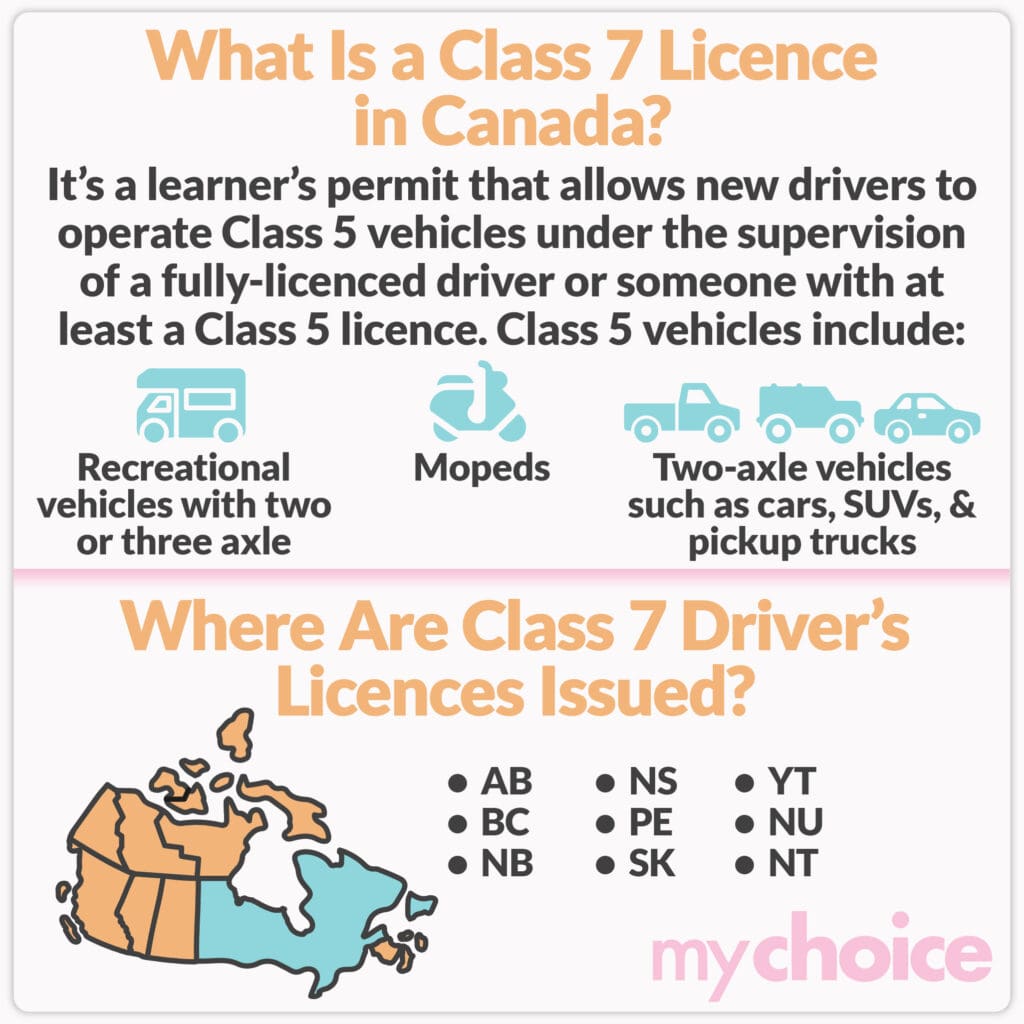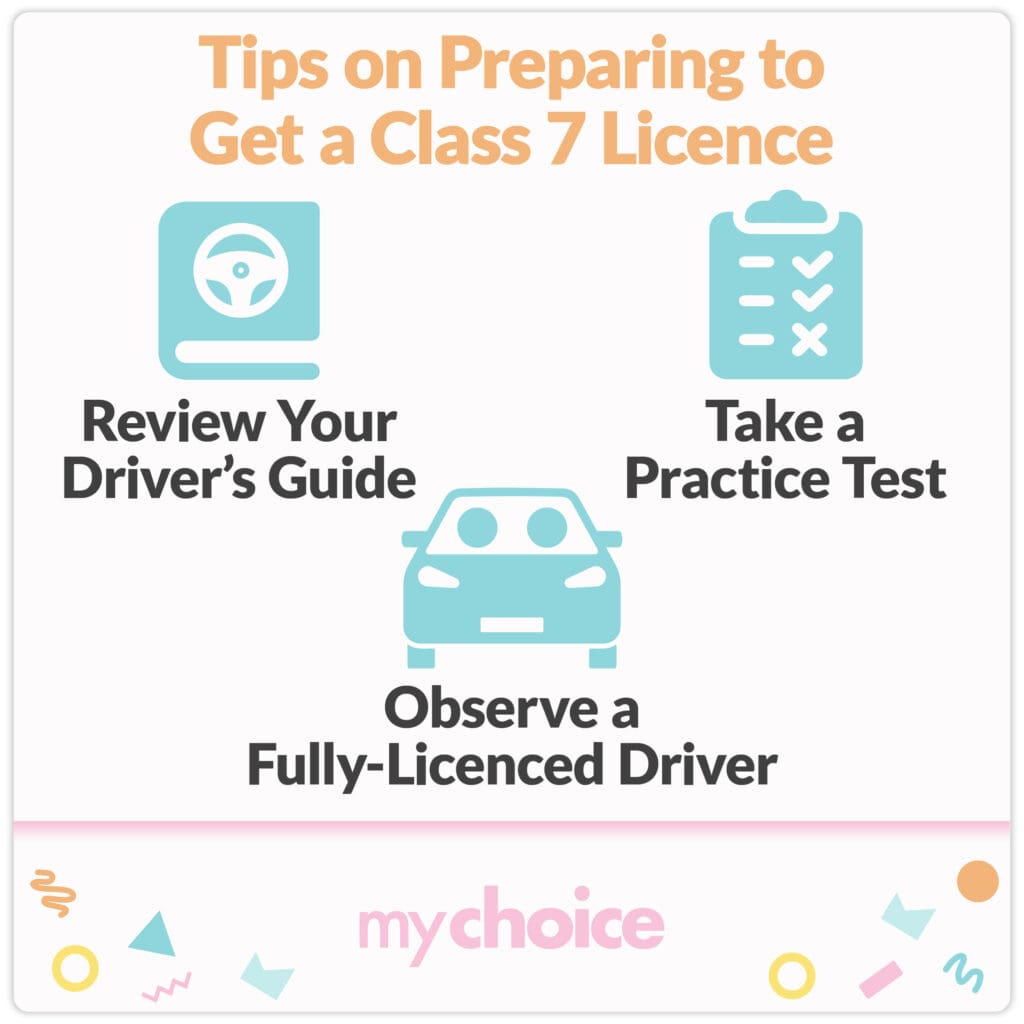
Issued in six provinces and three territories, a Class 7 licence is the first licence you’ll need to obtain as a young or first-time driver. It is considered a major milestone by many young Canadians in most parts of the country.
If you’re considering getting your driver’s licence for the first time, this is the guide for you. In this article, we cover the basics of what a Class 7 licence is, why it’s important, and how to get one. Read on to learn more.
What Is a Class 7 Licence in Canada?
A Class 7 licence is the first licence that is issued to young and first-time drivers in certain provinces and territories in Canada. In essence, it is a learner’s permit that allows new drivers to operate Class 5 vehicles under the supervision of a fully-licenced driver or someone with at least a Class 5 licence.
Class 5 vehicles include:
- Two-axle vehicles such as cars, SUVs, and pickup trucks
- Recreational vehicles with two or three axles like campers, motor homes, etc.
- Mopeds
The age of eligibility for a Class 7 licence varies from province to province. In Alberta, young drivers can apply for their learner’s permit as young as 14. In BC, drivers must be at least 16 years old to begin their Graduated Licensing Program (GLP).
Where Are Class 7 Driver’s Licences Issued?
This type of licence is issued in six Canadian provinces and all three territories, including:
- Alberta
- British Columbia (BC)
- New Brunswick
- Nova Scotia
- Prince Edward Island
- Saskatchewan
- Yukon
- Nunavut
- Northwest Territories
Other Areas
- Newfoundland and Labrador: Newfoundland and Labrador used to issue the Class 7 learner’s licence as well, but the province phased it out in 2002 and replaced it with the Class 5I novice driver permit.
- Manitoba: New drivers must obtain a Class 5L or vehicle learner’s licence before a Class 5I, which can only be acquired after completing a road test.
- Ontario: In Ontario, new drivers must go through the GLP, which entails obtaining a learner’s permit or G1, then a probationary licence or G2 after holding a G1 for at least one year.
- Quebec: First-time drivers must go through several levels of Class 5 licensing, including obtaining a learner’s licence and later a probationary licence.

Class 7 Licence in Alberta
In Alberta, all new drivers must apply for a Class 7 learner’s permit before they can obtain a Class 5 licence. Class 7 licences give Albertan drivers the right to operate Class 5 vehicles so long as there is a fully licenced driver in the front passenger seat with them.
The province has the youngest age of eligibility for learner’s permits, allowing applicants as young as 14 years of age. However, all applicants who are under 18 must have parental consent before applying.
Applicants are required to pass a knowledge exam and vision test, as well as provide proof of citizenship and proof of residence in Alberta.
Alberta Class 7 Restrictions
- Class 7 licence holders must always have a non-probationary licence holder over the age of 18 with them.
- Class 7 drivers cannot operate a vehicle at night, specifically between midnight and 5 am, even with supervision.
- Class 7 drivers cannot drive with a blood alcohol content above zero.
- Licences are suspended after eight demerit points, as opposed to the standard 15.
Not sure how demerit points work? Learn more on our blog, Understanding Demerit Points.
Class 7 Licence in BC
Under the BC GLP, the Class 7 licence is subdivided into two:
- Learner’s (L) licence: To get an L licence, you have to pass a multiple-choice knowledge test and vision screening.
- Novice (N) licence: You can get an N licence at least 12 months after getting an L licence. It requires a 45-minute Class 7 road test. Thus, L licence holders are encouraged to practice driving in various conditions (e.g., under supervision, of course) in preparation for the N licence road test.
To apply for a Class 7 licence in Vancouver or any other city in British Columbia, you must be at least 16 years of age. Those under 19 years of age are required to provide parental consent.
Can Class 7 drive on the highway in BC? Yes, they can, so long as they’re accompanied by a fully-licenced supervising driver. Let’s take a look at some of the other restrictions below.
BC Class 7 Restrictions
- Learners and novice drivers must display a magnetic “L” or “N” sign on their cars when driving.
- Drivers must be accompanied by a fully-licenced driver aged 25 or older.
- Learners can only have one additional passenger onboard, in addition to the supervising driver.
- Novice drivers are limited to one passenger only, exempting immediate family. When accompanied by a supervising driver, novice drivers may take on more than one passenger.
- There is a zero-tolerance policy for alcohol and drugs.
- Learners cannot drive between midnight and 5 am.
- Learners are not allowed to operate handheld electronic devices while driving, including Bluetooth devices or voice command-operated devices, except when dialling 911.
Class 7 Licence in New Brunswick
There are two types of Class 7 licences in New Brunswick: Level 1 and Level 2 licences.
In New Brunswick, drivers aged 16 and older can apply for a Class 7 licence. Those under the age of 18 must present parental consent before undertaking a vision, written, and sign test.
New Brunswick Class 7 Restrictions
- Level 1 licence holders can only operate a vehicle with the supervision of a fully-licenced driver.
- Level 1 licence holders can only drive between the hours of 5 am and 12 midnight. Level 2 licence holders may drive without supervision, but only within the aforementioned hours.
- Level 1 and Level 2 licence holders cannot drive with a blood alcohol content exceeding zero.
- Level 2 drivers cannot have more than three passengers at one time.
Class 7 Licence in Nova Scotia
Nova Scotia’s Class 7 licence is divided into two types: the standard Class 7, which allows learners to operate Class 5 vehicles with supervision, and the “LM” licence, which is issued to new motorcycle drivers.
New drivers in Nova Scotia can get their Class 7 licences at the age of 16 but need parental consent if they are under 18.
To obtain a Class 7 licence in Nova Scotia, you must undergo a knowledge and vision test. After twelve months, Class 7 licence holders can apply for a Class 5N (newly licenced) permit, then finally a Class 5 licence.
Nova Scotia Class 7 Restrictions
- Licence holders are only allowed to operate Class 5 vehicles with one passenger present. The passenger must be a fully-licenced Class 5 driver or higher.
- Class 7 licence holders cannot have a blood alcohol content higher than zero.
- Licence holders are not allowed to operate hand-held devices while driving.
Class 7 Licence in Prince Edward Island
There are three stages of Prince Edward Island’s GLP:
- Stage 1 (L), which requires a written exam
- Stage 2 (G), which requires having an L licence for at least 12 months and a passed road test
- Stage 3 (G), which requires completing Stage 2 and a wait of at least 12 months
In Prince Edward Island, anyone 16 or older can apply for an instruction driver’s permit or beginner’s permit. This grants a person the right to operate a Class 5 vehicle, motorcycle, or moped with the supervision of a fully-licenced driver. This permit is valid for two years from issuance.
Prince Edward Class 7 Restrictions
- Stage 1 (L) drivers must be accompanied by a fully-licenced supervisor who has held a valid licence for at least four years. The supervisor must sit in the front passenger seat at all times.
- Stage 1 (L) drivers cannot have other passengers aside from the supervisor and the licence holder’s immediate family.
- Stage 2 (G) drivers can be accompanied by only one non-family member. Other passengers must be immediate family members.
- Drivers of all stages must only have as many passengers as there are available seat belts.
- The driver must have a blood alcohol content of zero. The driving supervisor must not have a blood alcohol content of 0.05 or more.
- The driver cannot use a hand-held device while driving.
- The driver cannot drive from 1 am to 5 am if they are under the age of 21.
Class 7 Licence in Saskatchewan
As with other Class 7 licences covered above, Saskatchewan’s Class 7 licence allows new drivers to operate any vehicle that Class 5 holders can. Of course, restrictions apply.
In Saskatchewan, you can apply for a Class 7 licence as young as 15 years old. However, you must provide parental consent if you are under 19.
To obtain a licence, you must pass a knowledge and traffic sign test. There is also a vision test included in the knowledge exam.
Saskatchewan Class 7 Restrictions
- Drivers must be accompanied by a Class 5 licence-holding supervising driver. That supervisor must have held a valid licence for at least 12 months in the last three years.
- Drivers must not have a blood alcohol content that is higher than zero
- Drivers can operate a vehicle from midnight and 5 am but only with a supervising driver and immediate family
Class 7 Licence in Northwest Territories, Nunavut, and Yukon
In Nunavut, Yukon, and the Northwestern Territories (NWT), the minimum age to obtain a Class 7 licence is 15 years old. Applicants must undergo a vision test, a knowledge exam, and a written test in Nunavut and Yukon, and only a vision screening and knowledge exam in NWT.
There are two levels to Yukon’s GLP – the learner stage and the novice stage. Passing the learner stage allows applicants to obtain a Class 7 licence. After six months, learner’s permit holders can move forward to the novice Class 5 stage.
Class 7 Restrictions in Northwest Territories, Nunavut, and Yukon
- Drivers must be accompanied by a supervising driver with a Class 5 licence.
- There is a zero-tolerance policy for driving under the influence of drugs and alcohol.
- Drivers cannot operate a vehicle between midnight and 5 am.
How to Get a Class 7 Licence in Canada
The steps to how to get a Class 7 licence vary depending on where you live. But, for the most part, you’ll need to prepare the following:
- A valid photo ID card
- An original copy of a document (such as a passport or PR card) verifying your legal status in Canada
- Proof of residence in your province or territory, such as utility bills, copy of a land title, residential lease agreement, paystub, etc.
- Money to cover the cost of the licence test
- Written parental consent, if you’re underage
Tips on Preparing to Get a Class 7 Licence
Anxious about applying? Here are some ways you can prepare for your licence application:
Review Your Driver’s Guide
Visit your province’s website and look for your driver’s guide. This should cover everything you could be asked for in the knowledge test. The driver’s guide will contain key information on road safety, best practices for driving a vehicle, provincial laws, traffic signs, etc.
Take a Practice Test
There are plenty of practice tests available online. These will help you get a feel of how you’ll be tested on the day of and help you figure out which topics you’ll need to brush up on before taking the test.
Observe a Fully-Licenced Driver
Gather real-world experience by accompanying a full-licenced driver on a drive. Observe how they approach various traffic situations, ask questions about traffic signs and road rules, or even provide directions and instructions on what they should do next.

The Bottom Line
Obtaining a Class 7 licence in Canada is an important step for young drivers to take. Not only does having this type of licence provide greater freedom and mobility, but it can also give teenagers a sense of independence and responsibility. With the proper preparation and guidance, anyone can obtain their Class 7 licence and become a more experienced driver.
Aside from a licence, you’ll need car insurance to drive a new car. Check out our blog on car insurance tips for young drivers to find out how to get the best deals as a young driver. Once you’re ready to start shopping for insurance, use MyChoice to compare auto insurance rates among the top insurers in your area.








